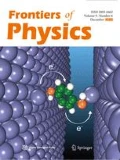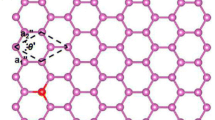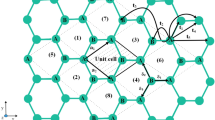Abstract
First-principles computations are performed to investigate phosphorene monolayers doped with 30 metal and nonmetal atoms. The binding energies indicate the stability of all doped configurations. Interestingly, the magnetic atom Co doping induces the absence of the magnetism while the magnetism is realized in phosphorene with substitutional doping of nonmagnetic atoms (O, S, Se, Si, Br, and Cl). The magnetic moment of transition metal (TM)-doped systems is suppressed in the range of 1.0–3.97 µB. The electronic properties of the doped systems are modulated differently; O, S, Se, Ni, and Ti doped systems become spin semiconductors, while V doping makes the system a half metal. These results demonstrate potential applications of functionalized phosphorene with external atoms, in particular to spintronics and dilute magnetic semiconductors.
Similar content being viewed by others
References
A. K. Geim and K. S. Novoselov, The rise of graphene, Nat. Mater. 6(3), 183 (2007)
A. H. Castro Neto, F. Guinea, N. M. R. Peres, K. S. Novoselov, and A. K. Geim, The electronic properties of graphene, Rev. Mod. Phys. 81(1), 109 (2009)
F. Schwierz, Graphene transistors, Nat. Nanotechnol. 5(7), 487 (2010)
Y. Wu, Y. M. Lin, A. A. Bol, K. A. Jenkins, F. Xia, D. B. Farmer, Y. Zhu, and P. Avouris, High-frequency, scaled graphene transistors on diamond-like carbon, Nature 472(7341), 74 (2011)
H. Liu, A. T. Neal, Z. Zhu, Z. Luo, X. Xu, D. Tománek, and P. D. Ye, Phosphorene: An unexplored 2D semiconductor with a high hole mobility, ACS Nano 8(4), 4033 (2014)
K. F. Mak, C. Lee, J. Hone, J. Shan, and T. F. Heinz, Atomically thin MoS2: A new direct-gap semiconductor, Phys. Rev. Lett. 105(13), 136805 (2010)
A. Splendiani, L. Sun, Y. B. Zhang, T. S. Li, J. Kim, C. Y. Chim, G. Galli, and F. Wang, Emerging photoluminescence in monolayer MoS2, Nano Lett. 10(4), 1271 (2010)
P. M. Bridgman, Two new modifications of phosphorus, J. Am. Chem. Soc. 36(7), 1344 (1914)
T. Nishii, Y. Maruyama, T. Inabe, and I. Shirotani, Synthesis and characterization of black phosphorus intercalation compounds, Synth. Met. 18(1–3), 559 (1987)
L. Li, Y. Yu, G. J. Ye, Q. Ge, X. Ou, H. Wu, D. Feng, X. H. Chen, and Y. Zhang, Black phosphorus field-effect transistors, Nat. Nanotechnol. 9(5), 372 (2014)
E. S. Reich, Phosphorene excites materials scientists, Nature 506(7486), 19 (2014)
L. Shulenburger, A. D. Baczewski, Z. Zhu, J. Guan, and D. Tománek, The nature of the interlayer interaction in bulk and few-layer phosphorus, Nano Lett. 15(12), 8170 (2015)
T. Low, R. Rold’an, H. Wang, F. N. Xia, P. Avouris, L. M. Moreno, and F. Guinea, Plasmons and screening in monolayer and multilayer black phosphorus, Phys. Rev. Lett. 113(10), 106802 (2014)
A. S. Rodin, A. Carvalho, and A. H. Castro Neto, Strain-induced gap modification in black phosphorus, Phys. Rev. Lett. 112(17), 176801 (2014)
X. Ling, H. Wang, S. Huang, F. Xia, and M. S. Dresselhaus, The renaissance of black phosphorus, Proc. Natl. Acad. Sci. USA 112(15), 4523 (2015)
J. Qiao, X. Kong, Z. Hu, F. Yang, and W. Ji, High-mobility transport anisotropy and linear dichroism in few-layer black phosphorus, Nat. Commun. 5(1), 4475 (2014)
F. Xia, H. Wang, and Y. Jia, Rediscovering black phosphorus as an anisotropic layered material for optoelectronics and electronics, Nat. Commun. 5(1), 4458 (2014)
R. Schuster, J. Trinckauf, C. Habenicht, M. Knupfer, and B. Büchner, Anisotropic particle-hole excitations in black phosphorus, Phys. Rev. Lett. 115(2), 026404 (2015)
J. Kim, S. S. Baik, S. H. Ryu, Y. Sohn, S. Park, B. G. Park, J. Denlinger, Y. Yi, H. J. Choi, and K. S. Kim, Observation of tunable band gap and anisotropic Dirac semimetal state in black phosphorus, Science 349(6249), 723 (2015)
P. K. Li and I. Appelbaum, Electrons and holes in phosphorene, Phys. Rev. B 90(11), 115439 (2014)
J. W. Jiang and H. S. Park, Negative Poisson’s ratio in single-layer black phosphorus, Nat. Commun. 5(1), 4727 (2014)
K. Sato, L. Bergqvist, J. Kudrnovský, P. H. Dederichs, O. Eriksson, I. Turek, B. Sanyal, G. Bouzerar, H. Katayama-Yoshida, V. A. Dinh, T. Fukushima, H. Kizaki, and R. Zeller, First-principles theory of dilute magnetic semiconductors, Rev. Mod. Phys. 82(2), 1633 (2010)
Z. F. Wang, S. Jin, and F. Liu, Spatially separated spin carriers in spin-semiconducting graphene nanoribbons, Phys. Rev. Lett. 111(9), 096803 (2013)
Y. C. Zhao and J. Ni, Spin-semiconducting properties in silicene nanoribbons, Phys. Chem. Chem. Phys. 16(29), 15477 (2014)
M. I. Katsnelson, V. Yu. Irkhin, L. Chioncel, A. I. Lichtenstein, and R. A. de Groot, Half-metallic ferromagnets: From band structure to many-body effects, Rev. Mod. Phys. 80(2), 315 (2008)
Y. Son, M. L. Cohen, and S. G. Louie, Half-metallic graphene nanoribbons, Nature 444(7117), 347 (2006)
D. D. Awschalom and M. E. Flatte, Challenges for semiconductor spintronics, Nat. Phys. 3(3), 153 (2007)
H. T. Wang, Q. X. Wang, Y. C. Cheng, K. Li, Y. B. Yao, Q. Zhang, C. Z. Dong, P. Wang, U. Schwingenschlögl, W. Yang, and X. X. Zhang, Doping monolayer graphene with single atom substitutions, Nano Lett. 12(1), 141 (2012)
A. V. Krasheninnikov, P. O. Lehtinen, A. S. Foster, P. Pyykkö, and R. M. Nieminen, Embedding transition-metal atoms in graphene: Structure, bonding, and magnetism, Phys. Rev. Lett. 102(12), 126807 (2009)
R. Wang, X. G. Ren, Z. Yan, L. J. Jiang, W. E. I. Sha, and C. G. Shan, Graphene based functional devices: A short review, Front. Phys. 14(1), 13603 (2019)
Z. N. Ma, J. B. Zhuang, X. Zhang, and Z. Zhou, SiP monolayers: New 2D structures of group IV–V compounds for visible-light photohydrolytic catalysts, Front. Phys. 13(3), 138104 (2018)
F. M. Xu, Z. Z. Yu, Z. R. Gong, and H. Jin, First-principles study on the electronic and transport properties of periodically nitrogen-doped graphene and carbon nanotube superlattices, Front. Phys. 12(4), 127306 (2017)
G. Kresse and J. Hafner, Ab initio molecular dynamics for liquid metals, Phys. Rev. B 47(1), 558 (1993)
G. Kresse and D. Joubert, From ultrasoft pseudopotentials to the projector augmented-wave method, Phys. Rev. B 59(3), 1758 (1999)
J. P. Perdew, K. Burke, and M. Ernzerhof, Generalized gradient approximation made simple, Phys. Rev. Lett. 77(18), 3865 (1996)
H. J. Monkhorst and J. D. Pack, Special points for Brillouin-zone integrations, Phys. Rev. B 13(12), 5188 (1976)
A. Brown and S. Rundqvist, Refinement of the crystal structure of black phosphorus, Acta Crystallogr. 19(4), 684 (1965)
X. H. Peng, Q. Wei, and A. Copple, Strain-engineered direct-indirect band gap transition and its mechanism in two-dimensional phosphorene, Phys. Rev. B 90(8), 085402 (2014)
S. Das, W. Zhang, M. Demarteau, A. Hoffmann, M. Dubey, and A. K. Roelofs, Tunable transport gap in phosphorene, Nano Lett. 14(10), 5733 (2014)
K. T. Chan, J. Neaton, and M. L. Cohen, First-principles study of metal adatom adsorption on graphene, Phys. Rev. B 77(23), 235430 (2008)
T. T. Tung, F. Alotaibi, M. J. Nine, R. Silva, D. N. H. Tran, I. Janowska, and D. Losic, Engineering of highly conductive and ultra-thin nitrogen-doped graphene films by combined methods of microwave irradiation, ultrasonic spraying and thermal annealing, Chem. Eng. J. 338, 764 (2018)
D. Mombrú, R. Faccio, and A. W. Mombru, Possible causes for rippling in a multivacancy graphene system, Int. J. Quantum Chem. 118(7), e25529 (2018)
Acknowledgements
This research was supported by the National Key Research and Development Program of China under Grant No. 2018YFB0703900 and the National Natural Science Foundation of China under Grant No. 11704322.
Author information
Authors and Affiliations
Corresponding authors
Rights and permissions
About this article
Cite this article
Feng, JH., Li, G., Meng, XF. et al. Computationally predicting spin semiconductors and half metals from doped phosphorene monolayers. Front. Phys. 14, 43604 (2019). https://doi.org/10.1007/s11467-019-0904-5
Received:
Accepted:
Published:
DOI: https://doi.org/10.1007/s11467-019-0904-5




